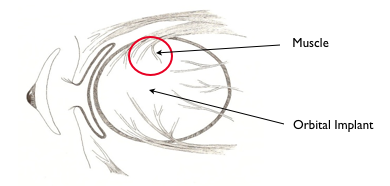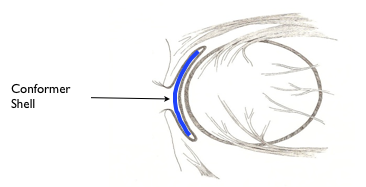by Paul, Jenny and Emily Geelen
The Operation
When an eye is diseased or damaged, the situation may arise where an operation is required to prepare for the fitting of an artificial eye. An Ophthalmologist is involved in assessing the need for an operation, which is only undertaken as a last resort.
An artificial eye is shell shaped. It is designed to sit over a ball-shaped orbital implant that takes the place of the eyeball, and is supported in place by the eye lids.
Before the Operation
It is advised that you should avoid alcohol before (and after) the operation as there are anaesthetics and antibiotics involved.Eye Removal
The first step in the surgery is the preparation of the eye socket.- Enucleation – the most common preparation is enucleation (removal) of the damaged or diseased eyeball.
- Evisceration – less frequently, the sclera of the eyeball (the leathery outer casing) is retained.
Orbital Implant
The second step in the surgery is the fitting of a spherical orbital implant. There are various types of orbital implants. They can be made from acrylic, coral or synthetic coral type materials. The final artificial eye will fit over this orbital implant and under the eye lids. The muscles are attached to the orbital implant so the muscles of the eye can move the orbital implant (and therefore the artificial eye).
Conjunctiva
The third step in the surgery is to bring the conjunctiva across the front of the orbital implant and suture (stitch) it in place. The conjunctiva is the tissue you find on the inside of the eyelid.
Conformer Shell
The fourth step in the surgery is the fitting of the conformer shell. As the final artificial eye is not available at the time of surgery, a clear plastic conformer shell is fitted to hold the shape of the eye socket and allow the eye lids to blink over the shell without rubbing the suture line.

Going Home
The Ocularists Association of Australia has prepared a brochure called Going home after Eye Surgery. Essentially the message is to give yourself the chance to heal. After the operation you should avoid heavy lifting. Walking and light cardio work is recommended. We were once asked by a seventy year old lady if it is ok to do headstands two weeks after the operation. While we were impressed that she could still do a headstand we advised her to give it a few more weeks. It is best to keep your head elevated to avoid pressure. This means using an extra pillow and generally taking it easy.A Few Final Notes about Artificial Eyes
Thanks to Hollywood movies, specifically “Pirates of the Caribbean”, it is widely believed that a prosthetic eye is spherical. The orbital implant that is surgically fitted is spherical, but it can not be removed. The artificial eye that is removable has a thin shell shape – see illustration. It is a quirk of monocular vision that you can not see the full movement of your artificial eye in a mirror. To get a true appreciation of the movement of your artificial eye you should video record the eye while you look left, right, up and down.Things to Remember Before, During and After the Operation
